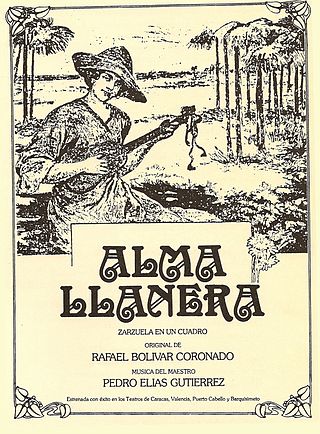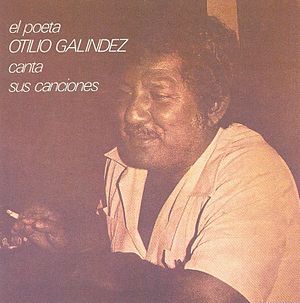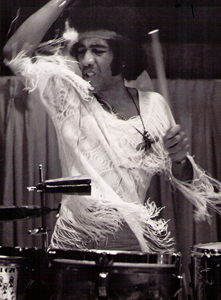
Several styles of the traditional music of Venezuela, such as salsa and merengue, are common to its Caribbean neighbors. Perhaps the most typical Venezuelan music is joropo, a rural form which originated in the llanos, or plains.

The Capital District is a federal district of Venezuela. It has an area of 433 km2 (167 sq mi) and there is only one administrative division (municipio), Libertador, which contains about half of Caracas, the Venezuelan capital city, which is also the seat of the three branches of the federal government of Venezuela. The population in 2004 was 2,073,768. The District borders on the states of Vargas and Miranda.

Alberto Naranjo [nah-rahn'-ho] was a Venezuelan musician. His mother, the singer Graciela Naranjo, was a radio, film and television pioneer in her homeland. Largely self-taught, Naranjo embarked on a similar musical course, becoming – like his mother – one of Venezuela's icons of contemporary popular music.

El Hatillo Municipality is an administrative division of the State of Miranda, Venezuela; along with Baruta, Chacao, Libertador and Sucre, it is one of the five municipalities of Caracas, the capital of Venezuela. It is located in the southeastern area of Caracas, and in the northwestern part of the State of Miranda.

Simón Narciso Díaz Márquez, also known as tío Simón, was a Venezuelan singer, actor, TV host, comedian, and Grammy Award-winning composer of Venezuelan music. Some of his most popular songs include Caballo viejo, Tonada de luna llena and La vaca Mariposa.

Otilio Galíndez was a Venezuelan songwriter and musician. He is best known for his Christmas songs (aguinaldos) like "La Restinga", even though he also composed popular Venezuelan waltzes, serenades, bambucos or joropos such as "Pueblos tristes", "Flor de mayo" and "Mi tripón". Many of his songs have been recorded by María Teresa Chacín, Ilan Chester, Simón Díaz, Pablo Milanés, Silvio Rodríguez, Mercedes Sosa, Cecilia Todd and Lilia Vera, among others.
Famasloop is a Latin Grammy-nominated electronic music band from Caracas, Venezuela. The band's members are Alain Gómez, Luis Daniel González, Ricardo Martínez, Rafael Urbina and Vanesa Gouveia. The group's first album, Tres Casas, which was released in June 2006, experimented with electronic music to integrate several genres such as pop, Latin, rock, hip-hop, trip hop, Afro-Venezuelan, classical, Hindu, tango and jazz.

Imagen Latina is an album by Venezuelan musician Alberto Naranjo, originally released in 1992 and reedited thrice in 2002, 2008 and 2012. It is the seventh album of El Trabuco Venezolano musical project arranged and directed by Naranjo.
Los Melódicos are a Venezuelan band founded in 1958. Los Melódicos play música tropical, a genre developed on the Caribbean coasts of Venezuela, Colombia, and other Central American and Caribbean countries in the mid 20th century.

Rubén Cedeño, is a Venezuelan musician, composer, painter, writer and speaker on metaphysical subjects. He was a disciple of Conny Méndez, who in 1946 founded the Metaphysical Teachings in Venezuela. He was one of her students and they had a very close relationship based on the teachings and their friendship as well. Rubén Cedeño has been writing and speaking publicly on Metaphysics for many years and as a result of his efforts, he founded or inspired the foundation of metaphysical groups in Argentina, Venezuela, Colombia, Chile, Uruguay, Paraguay, Ecuador, Bolivia, El Salvador, Peru, Mexico, Panama, United States, Spain, Italy, France, Belgium and Switzerland. He wrote more than 300 books, some of which have been translated to English, Italian, French and Portuguese and hold a place in many national libraries, such as Library of Alexandria, Egypt, Library of the Congress, National Library of Spain, Jewish National and University Library, National Library of Italy. His core message can be summarized in positive thinking, self-knowledge, the Inner Christ, the Seven Aspects of God, forgiveness practice and compassionate love. Rubén Cedeño holds a place in the Encyclopedic Music of Venezuela and he is among the most famous musicians of Venezuela. He graduated from the Conservatory of Music "Juan Manuel Olivares" in Caracas, Venezuela as a Professor of Singing. In Hungary, he specialized in Kodaly method and composed the Hungarian merengue "Having Chereznye Palinka". As composer of folk and infantile music the most recognized works are: The Aguinaldo Que Navidad part of the Venezuelan Christmas repertoire and interpreted by the mezzosoprano Morella Muñoz, Cantata infantil Simón Bolívar, Misa de Mi Tierra among others. It was National Prize of popular music of the INAVI with his valse Nora. The hymn Hail to the Statue of Liberty, received the congratulation of President Ronald Reagan.

Héctor José Regalado was a Venezuelan Latin music bandleader, percussionist, composer and educator. He played professionally under the name Rudy Regalado.
Gonzalo Grau y la Clave Secreta are a jazz band which originated in Boston, Massachusetts, United States.
Benito Canónico was a Venezuelan composer, musician, orchestrator and teacher.

Barbarito Díez was a Cuban singer who specialized in danzón. He began his career as the singer for Graciano Gómez and Isaac Oviedo's son group, before joining Antonio María Romeu's orchestra. As the lead vocalist for Romeu's ensemble for 20 years, he established himself as one of the main exponents of the sung danzón. He continued singing with his own charanga, as well as other groups, for another 30 years. He also toured and recorded in Venezuela and Puerto Rico before retiring in the early 1990s, when complications from diabetes prevented him from performing and eventually resulted in his death in 1995. A naturally-gifted tenor, he was known for his sense of rhythm, correct diction and romantic style.

This is a list of notable events in Latin music that took place in 2015.
Los Cuñaos[coo-nyah'-os] is an eight-part vocal group established in Caracas, Venezuela in 1974. Their repertoire is based on popular Venezuelan songs adapted to their own unique style of singing, performing a crossover of traditional and pop genres while contrasting their work with rich and warm harmonies.

Yordano, born Giordano Di Marzo Migani, is an Italian–born Venezuelan singer-songwriter and guitar player.
Silvano Monasterios is a Venezuelan jazz musician, pianist, composer and orchestrator.

Domingo en llamas was a Venezuelan band formed in Caracas in 2005 by José Ignacio Benítez, the only constant member.













